Käthe Kollwitz: Memorialization as Anti-Militarist Weapon
Abstract
:When someone dies because he has been sick—even if he is still young—the event is so utterly beyond one’s powers that one must gradually become resigned to it. He is dead because it was not in his nature to live. But it is different in war. There was only one possibility, one point of view from which it could be justified: the free willing of it. And that in turn was possible only because there was the conviction that Germany was in the right and had the duty to defend herself. At the beginning it would have been wholly impossible for me to conceive of letting the boys go as parents must let their boys go now, without inwardly affirming it—letting them go simply to the slaughterhouse. There is what changes everything. The feeling that we were betrayed then, at the beginning. And perhaps Peter would still be living had it not been for this terrible betrayal. Peter and millions, many millions of other boys. All betrayed.Käthe Kollwitz, 19 March 1918.1
I’m back in the middle of etching (…). Yes, I jumped with both feet into a work that I suspected was always hovering darkly since 1914 but which I postponed again and again. Now it seemed like a direct call to me and I started it. Plates about the War. Until now only drawings existed. Never shown to anyone. Drawn under tears.
I first began the War series as etchings. Came to nothing. Dropped everything. […] If woodcutting fails, then I have proof that the fault lies only within myself. Then I am just no longer able to do it. In all the years of torment these small oases of joys and successes!
The deep seriousness of Käthe Kollwitz finds its focus in her devotion to a single earthly phenomenon, the Ecce Homo of the poor and the downtrodden. […] The swelling richness of human forms […], the shimmering realm of infinite beauty—all this is hateful to her. In the one gloomy theme, she finds her one and only language.
I even still say to myself, if it came to a choice between the dictatorship of Ebert and the dictatorship of (Spartacist leader and Communist Party founder Karl) Liebknecht, I certainly would vote for Ebert […] I have lived through the war and seen Peter and the thousand other youths die; I am horrified and shocked by all the hate that is in the world. I yearn for socialism, which allows men to live, and think that the earth has now seen enough of murder, lies, destruction, mutilation, in short everything devilish. The communistic state that builds itself thereupon cannot be God’s work.
Your letter and greeting were for me a great pleasure. Throughout the war, in the four dark years, your name—and a few others—was a kind of comfort. Because you represented what one longed to hear. I thank you for remembering our dead son. It’s been eight years today since he fell. He was in the field for ten days, then his eighteen-year life ended. He went believing and died like that. His friends had it even harder, all of whom fell in the course of these four years. Their faith faltered and became hate and disgust with the war. But the war did not release them, they almost all had to bleed to death in their most beautiful youth. All of us—in all the warring countries—have borne the same. I have tried again and again to represent the war. I could never grasp it. Now finally I have completed a series of woodcuts which to some extent say what I wanted to say. […] These prints should travel everywhere and should summarize to everyone: that is how it was—that is what we have all borne during these unspeakably difficult years.
[The Widow II] beaten to the ground by grief, lies numb on the white [ground]. Naked and far away, icy feet rise up; thrown over her chest and neck, the tired weeping child sleeps. But over him, in sleep still protective […] the clammy hand of the unconscious, frozen body. […] The Volunteers, with Death leading the way into the blackness. […] And then, sublime form: the chapel of sorrow built from the bodies of father and mother, fused together from wailing for the fruit of their love, which is unripe, prematurely rotting under the earth. [In The People], the face of a female martyr, of will incarnate, determined to give and protect the life and beauty in her womb. A humanity that contains powers like the soul of this woman, this humanity will not perish, mangling itself. Maternal love, that is the beginning of all things, in Käthe Kollwitz stands up to call and warn. 0, that all continents would hear it!
When one enters the hall, which serves the purpose of the museum for the time being, […] the first thing that is striking is the bloodcurdling domestic war etching by Käthe Kollwitz and engravings by Dusseldorf’s Otto Dix. Pictures of horror! Shaking your head, you turn away.
Under this title the Socialist Workers’ Youth, West Saxony District, publishes an excellent small publication. It is so important and so valuable to us pacifists because it expresses the determination, the unconditionality and the will to act of those who are most important, the masses of youths who would be the army in the next war. […] This colourful muddle of visual arts, poetry, politics and science, which stand side by side here, becomes the most wonderful coexistence of various forms of expression for equal paths, for equal will. In addition to pictures by Käthe Kollwitz, Dix, George Groß, Masereel, there are words by Toller, Eisner, Engelke. The eternally young, Karl Liebknecht and Rosa Luxemburg, again have their say in this book of youth. […] This manifesto should be available to all those who want to learn from a truly young, antimilitarist fighting spirit.
Funding
Conflicts of Interest
References
- Alexander, Gertrude. 1920. Arbeiter-Kunst-Ausstellung. Die Rote Fahne, October 12, 5. [Google Scholar]
- Bader, Herbert. 1979. Nie wieder Krieg. Der Kampf für Frieden und Abrüstung seit 1900. Eine Dokumentation. Berlin: Elefanten Press. [Google Scholar]
- Bessel, Richard. 1993. Germany after the First World War. London: Clarendon Press. [Google Scholar]
- Bittner, Herbert. 1959. Kaethe Kollwitz. Drawings. London and New York: Thomas Yoseloff. [Google Scholar]
- Bohnke-Kollwitz, Jutta, ed. 1992. Käthe Kollwitz, Briefe an Den Sohn: 1904 Bis 1945. Berlin: Siedler. [Google Scholar]
- Bohnke-Kollwitz, Jutta, ed. 2012. Käthe Kollwitz. Die Tagebücher 1908–1943, New edition. Munich: btb. [Google Scholar]
- Bonus Jeep, Beate. 1948. Sechzig Jahre Freundschaft mit Käthe Kollwitz. Boppard: Rauch. [Google Scholar]
- Dehmel, Richard. 1918. Einzige Rettung. Vorwärts, October 22, 7. [Google Scholar]
- Friedrich, Ernst, ed. 1921. Proletarischer Kindergarten Ein Märchen- und Lesebuch für Groß und Klein. Berlin: Buchverlag der Arbeiter-Kunst-Ausstellung. [Google Scholar]
- Heckmann, Stefanie, and Hans Ottomeyer. 2009. Kassandra. Visionen des Unheils 1914–1945. Dresden: Sandstein. [Google Scholar]
- Heinemann, Dora. 1924. Review. Nie Wieder Krieg. Berliner Wissenschafts-Verlag 24: 246–47. [Google Scholar]
- Hille, Karoline. 2017. Paragraph 218 and the “Women’s Matter”. In Splendour and Misery in the Weimar Republic. Edited by Ingrid Pfeiffer. Munich: Hirmer, pp. 183–95. [Google Scholar]
- Hoffmann, Tobias, ed. 2018. Berliner Realismus. Von Käthe Kollwitz bis Otto Dix. Sozialkritik—Satire—Revolution. Cologne: Wienand Verlag. [Google Scholar]
- Käthe Kollwitz-Museum, Berlin, ed. 2017. Käthe Kollwitz und ihre Freunde. Berlin: Lukas Verlag. [Google Scholar]
- Kollwitz, Käthe. 1918. An Richard Dehmel! Entgegnung von Käthe Kollwitz. Vorwärts, October 28, 3. [Google Scholar]
- Kollwitz, Hans, ed. 1981. “Ich will wirken in dieser Zeit”: Auswahl aus den Tagebüchern und Briefen, aus Graphik, Zeichnungen und Plastik, 5th ed. Berlin: Mann. [Google Scholar]
- Kollwitz, Hans, ed. 1985. Ich sah die Welt mit liebevollen Blicken: Ein Leben in Selbstzeugnissen, 8th ed. Wiesbaden: Fourier. [Google Scholar]
- Kollwitz, Hans, ed. 1988. The Diary and Letters of Kaethe Kollwitz. Clara Winston, and Richard Winston, transs. Evanston: Northwestern University Press. [Google Scholar]
- Kühn, Fritz, ed. 1924. Nie Wieder Krieg! Leipzig: Sozialistische Arbeiter-Jugend, Bezirk West-Sachsen. [Google Scholar]
- Kühn, Fritz, ed. 1925. Nie Wieder Krieg. Leipzig: Roter Türmer Verlag. [Google Scholar]
- McCausland, Elizabeth. 1937. Käthe Kollwitz. Parnassus 9: 20–25. [Google Scholar] [CrossRef]
- Mosse, George L. 1991. Fallen Soldiers: Reshaping the Memory of the World Wars. Oxford: Oxford University Press. [Google Scholar]
- Nagel, Otto, ed. 1972. Käthe Kollwitz. Die Handzeichnungen (Catalogue Raisonné). Berlin: Henschelverlag Kunst und Gesellschaft. [Google Scholar]
- Prelinger, Elizabeth. 1992. Käthe Kollwitz. Washington, DC: National Gallery of Art. [Google Scholar]
- Rolland, Romain. 1921. Die Zeit wird kommen. Drama in Drei Akten. Leipzig: EP Tal & Co. Verlag. [Google Scholar]
- Sharp, Ingrid. 2011. Käthe Kollwitz’s Witness to War: Gender, Authority, and Reception. Women in German Yearbook 27: 87–107. [Google Scholar] [CrossRef]
- Siebrecht, Claudia. 2013. The Aesthetics of Loss: German Women’s Art of the First World War. Oxford: Oxford University Press. [Google Scholar]
- Spree, Tommy. 2017. Ich kenne keine Feinde. In Krieg dem Kriege. Edited by Anti-Kriegs-Museum. Berlin: Anti-Kriegs Museum. [Google Scholar]
- von dem Knesebeck, Alexandra, ed. 2002. Käthe Kollwitz. Werkverzeichnis der Graphik. Bern: Verlag Kornfeld. [Google Scholar]
- Wentscher, Dora. 1924. Käthe Kollwitz. Die Weltbühne 20: 110–12. [Google Scholar]
- Whitner, Claire, ed. 2016. Käthe Kollwitz and the Women of War. Femininity, Identity and Art in Germany during World Wars I and II. New Haven: Yale University Press. [Google Scholar]
- Ziemann, Benjamin. 2013. Contested Commemorations: Republican War Veterans and Weimar Political Culture. Cambridge: Cambridge University Press. [Google Scholar]
- Zweig, Stefan. 1921. Romain Rolland. The Man and His Work. Translated by Eden Paul, and Cedar Paul. New York: Thomas Seltzer. [Google Scholar]
| 1 | Kollwitz (1988, p. 87), original German in (Bohnke-Kollwitz 2012, p. 359). In Bohnke-Kollwitz, the text is dated 20 March 1918. Hans Kollwitz’s English language edition of his mother’s diary and letters, originally published in 1955, includes only a very limited number of diary entries and letters. Hans’s much more extensive German compilations include (Kollwitz 1981, 1985). Bohnke-Kollwitz’s edition of her grandmother’s diaries (Jutta was Hans’s daughter) is comprehensive (accompanied by detailed notes), though it is possible that not all entries are included. Where an entry also appears in the English edition of the diaries and letters, the references for both the English and the German edition will be given. In all other German sources, the translations are my own. |
| 2 | The German Nie wieder Krieg [No More War] movement (not to be confused with the British No More War Movement (NMWM), founded 1921) existed from the beginning of World War I, growing to much greater numbers by 1920, the first year that the major annual demonstrations were held in various German cities on the anniversary of the outbreak of World War I (1 August 1914), and which would continue in force until 1925, when numbers had already begun to wane. By 1921, more than twenty antiwar organisations had been formed in Germany as part of the Nie wieder Krieg movement. See for example (Bader 1979). For insight into postwar German politics and society in relation to war commemoration, see for example (Ziemann 2013). |
| 3 | A rich body of antiwar art was produced in Germany between 1914 and 1945, and many of the artists remain little studied. See (Heckmann and Ottomeyer 2009). |
| 4 | (Whitner 2016; Prelinger 1992, pp. 13–14). Kollwitz was included in (Siebrecht 2013). German-only publications include (Hoffmann 2018; Käthe Kollwitz-Museum Berlin 2017). |
| 5 | |
| 6 | |
| 7 | |
| 8 | Diary entry, Monday, 10 August 1914, in (Bohnke-Kollwitz 2012, p. 152). |
| 9 | Dehmel (1918, p. 7). Translated article title: Sole Salvation. |
| 10 | Kollwitz (1918, p. 3). Translated article title: To Richard Dehmel! A Response from Käthe Kollwitz. The article is translated into English in Han’s Kollwitz’s edition. See (Kollwitz 1988, pp. 88–89). The ‘greater poet’ Kollwitz refers to is Goethe. |
| 11 | Popular publications such as those by the Reicharchiv [Reich Archive] fulfilled an important role in publishing the accounts of ordinary soldiers’ war experiences, but there was little to debunk what cultural historian George Mosse called the Myth of the War Experience, which glorified military experience as a ‘man-making’ exercise while playing down the savagery of modern warfare and its physical and psychological impact on soldiers. See (Mosse 1991). Militant organizations such as the Freikorps and the Stahlhelm were formed barely a month after the Armistice and played a cardinal role in converting the myth into a militarized, political mass movement. For a detailed account of postwar Germany and militarism, see, for example, Richard Bessel’ (1993) landmark study. |
| 12 | ‘I am ashamed that I still do not take sides and almost suspect that if I declare that I belong to no party, the real reason for this is cowardice. Actually, I am not revolutionary at all, but evolutionary, because I am praised as an artist of the proletariat and the revolution and I am increasingly pushed into the role’. Diary entry, October 1920 (no exact date given). See (Bohnke-Kollwitz 2012, p. 483). |
| 13 | Diary entry, 8 December 1918 (ibid., p. 388). |
| 14 | Kollwitz reveals in this letter that she was also hesitant to make known her experiences and feelings on the war, as well as the discrepancy she felt between the themes of life and death and the ‘stuperous nature of studio work’. See (Bohnke-Kollwitz 1992, p. 163). |
| 15 | Diary, 25 June 1920. See (Kollwitz 1988; Bohnke-Kollwitz 2012, p. 477). The italics are used only in Bohnke-Kollwitz. |
| 16 | Kollwitz’s drawing illustrated the title page of the fourth and fifth printings of the German version, (Rolland 1921) and the version of the drawing used for the title page is lost (Nagel 1972, p. 354). Each copy is numbered up to a total of 1000 copies. The play was written in 1903 and explored numerous antiwar themes through an episode in the Boer War (1899–1902). Rolland described Kollwitz in 1927 thus: ‘The work of Kaethe Kollwitz, which reflects the ordeal and pain of the humble and simple, is the grandest German poem of this age. This woman of virile heart has looked on them, has taken them into her motherly arms, with a solemn and tender compassion. She is the voice of the silence of the sacrificed’. See for example (Bittner 1959, p. 8). |
| 17 | |
| 18 | Nagel (1972, p. 355) records three separate sheets with drawings for Zwei Tote. The less developed of the two further drawings (in pencil) is held by the Kollwitz Museum, Cologne (NT (830a)). |
| 19 | |
| 20 | Kollwitz, letter to Max Lehrs, 1 February 1921 (Archive of the Staatliche Kunstsammlungen Dresden), quoted in (Nagel 1972, p. 472). Lehrs was the Director of the Kupferstich-Kabinett (Prints and Drawings Cabinet) at the SKD, the first museum to promote Kollwitz, and Lehrs is widely credited with establishing Kollwitz as an artist. |
| 21 | |
| 22 | See timeline of the artist’s life on the website of the Käthe Kollwitz Museum, Cologne: https://www.kollwitz.de/zeitstrahl. |
| 23 | Diary, 25 January 1919 (Bohnke-Kollwitz 2012, p. 402). |
| 24 | See (Nagel 1972, pp. 340–52). |
| 25 | Käthe Kollwitz, Memorial Sheet for Karl Liebknecht, 1920. Woodcut, 34.9 cm × 49.9 cm; sheet: 47.7 cm × 63.7 cm. The final print, together with other versions and a number of preparatory drawings can be viewed on the website of the Käthe Kollwitz Museum, Cologne: https://www.kollwitz.de/gedenkblatt-fuer-karl-liebknecht. |
| 26 | See the information on the webpage for the drawing on the website of the Käthe Kollwitz Museum Cologne: https://www.kollwitz.de/dem-andenken-ludwig-franks. |
| 27 | This sculpture (German: Liegender toter Soldat or Toter Soldat), now known only through the photograph, formed part of an abandoned design for a three-figure memorial (father, mother, son). Kollwitz later created the two-figure work Grieving Parents (1932), now at Vladslo German war cemetery, Belgium, where Peter is buried. ‘I have begun a work for Peter, to honour him and to honour all the young fallen volunteers. […] A sacorphagus or rather a smooth, simple long base on which the young dead man lies’. Letter to Beate Bonus-Jeep, (undated/1915), (Bonus Jeep 1948, p. 188). |
| 28 | |
| 29 | (Alexander 1920, p. 5). Kollwitz noted the criticism in her diary in October 1920 (no exact date given). See (Bohnke-Kollwitz 2012, p. 483). |
| 30 | Diary entry, October 1920 (no exact date given), (Bohnke-Kollwitz 2012, p. 483). |
| 31 | Käthe Kollwitz, War, 1918–22/23. Cyle of seven woodcuts, slightly variable proportions, average size 47.5 cm × 65.4 cm. The entire cycle of War, together with various preparatory prints and drawings, can be viewed on the website of the Käthe Kollwitz Museum, Cologne: https://www.kollwitz.de/folge-krieg-uebersicht. |
| 32 | |
| 33 | |
| 34 | Kollwitz had been elected to the Prussian Academy in 1919, the first woman so elected in over a hundred years. Kollwitz had just seen Barlach’s play, Die echten Sedemunds (1921). Barlach created numerous antiwar prints and sculptures in the postwar period. |
| 35 | Bohnke-Kollwitz (2012, p. 540). ‘I have received a good letter from Romain Rolland’ [Ich habe einen guten Brief von Romain Rolland bekommen]. |
| 36 | Ibid., pp. 877–78. |
| 37 | Kollwitz (1988, p. 104). See (Bohnke-Kollwitz 2012, p. 542). The English translation gives no specific date (November 1922). Bohnke-Kollwitz dates the entry as 4 December 1922. |
| 38 | |
| 39 | Kollwitz (1988, p. 64). See (Bohnke-Kollwitz 2012, pp. 184–85). Standing Mother, Pressing Baby to Face, 1915, charcoal on grey paper fixed with shellac, Käthe Kollwitz Museum, Cologne. |
| 40 | The Widow II (discarded first version), before May 1920. Lithograph, 38 cm × 62 cm. Dr. Richard A. Simms Collection, Getty Research Institute, Los Angeles. Nagel (1972, pp. 386–87) records two related drawings. Knesebeck records one lithographic trial for the first version (von dem Knesebeck 2002, pp. 462–63), one lithograph and two woodcut states for the second version (ibid., pp. 464–65, 528–29) and seven states of the final woodcut composition (ibid., pp. 530–33). |
| 41 | This print’s composition reappears in sculpted form in Tower of Mothers (1937/38). Kollwitz had noted the idea of creating a sculpted version of the print on 30 April 1922, describing it as a circle of standing mothers protecting their children, sculpted in the round. See (ibid., pp. 530–31). |
| 42 | (von dem Knesebeck 2002, pp. 173–76, 178–79, 190). Edition A of 100 was printed on imperial Japan paper; Edition B of 100 was printed on wove paper, and Edition C of 200 was printed more cheaply from an electrotype plate on imitation Japan paper. Edition A: Käthe Kollwitz, Krieg, 1923. Portfolio of seven woodcuts and one woodcut cover (Die Witwe I), each sheet approx. 47.6 cm × 65.9 cm. Emil Richter, Dresden. |
| 43 | |
| 44 | (Friedrich 1921). The book featured work by Otto Nagel and others in addition to Kollwitz. |
| 45 | |
| 46 | Kollwitz, Nieder mit den Abtreibungs-Paragraphen [Down with the Abortion Paragraph], 1923. The prohibition was entered into the Criminal Code of the German Empire in 1871, and meant that a woman who underwent an abortion as well as whoever performed the abortion would receive a prison sentence. See for example (Hille 2017, pp. 183–95). The new independence of women, brought about by the new dependence on women as a consequence of the war effort, and particularly because women had been granted suffrage on 30 November, 1918, brought the issue of the Abortion Paragraph to a head because it was a tax on women’s autonomy. |
| 47 | Bohnke-Kollwitz (2012, p. 880) also notes that they were also important for financial reasons: ‘With some relief, she writes to her son Hans on 21 September: “Today comes [Edo] Fimmen and brings me 200 Dutch guilds for the antiwar poster”’. Fimmen was Secretary General of the IFTU. |
| 48 | Kollwitz, quoted in (von dem Knesebeck 2002, p. 585). |
| 49 | Another version of the poster was printed for the German antiwar day on 21 September 1924, with the same text as before and with additional text beneath: Antikriegstag am 21 September 1924. The Internationale Gewerkschaftsbund are credited in smaller text at the bottom left. See von dem Knesebeck (2002, pp. 582–85) for this and further details regarding the various international versions of the poster. |
| 50 | The previously mentioned Freikorps included many young men who were too young to fight in 1914. Kollwitz did not define the figure in Nie wieder Krieg! as either male or female in her written accounts. |
| 51 | For the reference to Westphal, see the website of the Käthe Kollwitz Museum, Cologne: https://www.kollwitz.de/plakat-nie-wieder-krieg. |
| 52 | The reproductions of Kretzschmar’s works were Das Gespenst des Krieges [The Spectre of War] and Der Schutzengraben [The Trench]. Masereel’s were Das ist kein Traum [This is not a Dream] and Die Toten reden [The Dead are Talking]. |
| 53 | Mehring also contributed to Die Weltbühne, edited by Kurt Tucholsky up to 1927 and then by Carl von Ossietsky. |
| 54 | (Kühn 1924). |
| 55 | (Heinemann 1924). The precocious journalist and writer Heinemann was committed to social justice from an early age, and became a fervent anti-Nazi activist. She was found dead in London, under mysterious circumstances, on 4 April 1935. |
| 56 | |
| 57 | See the aforementioned (Heckmann and Ottomeyer 2009) for insight to German antiwar art during the Weimar Republic. The book includes work by seventy-seven artists. |
| 58 | Ibid., p. 8. |
| 59 | Ibid. |
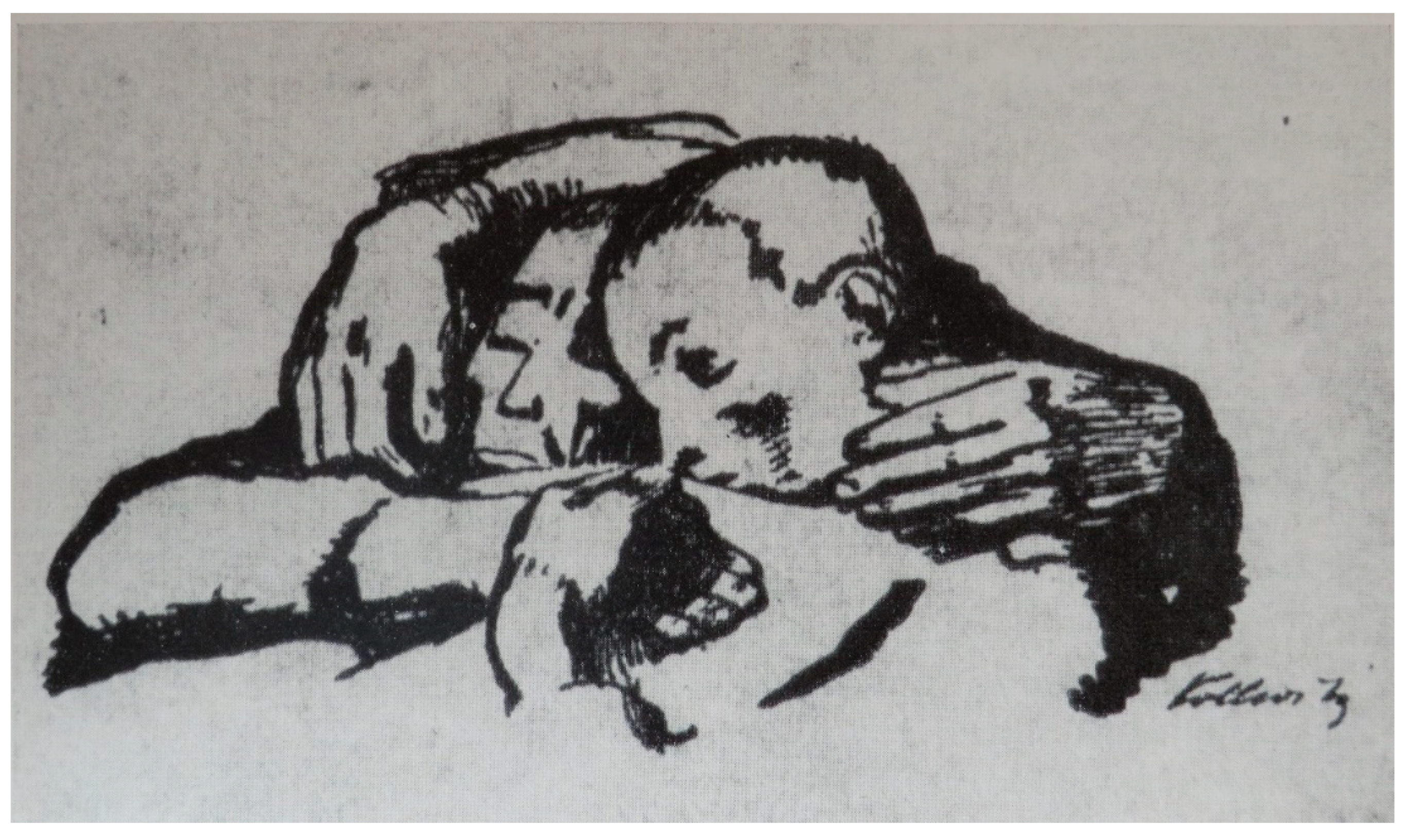
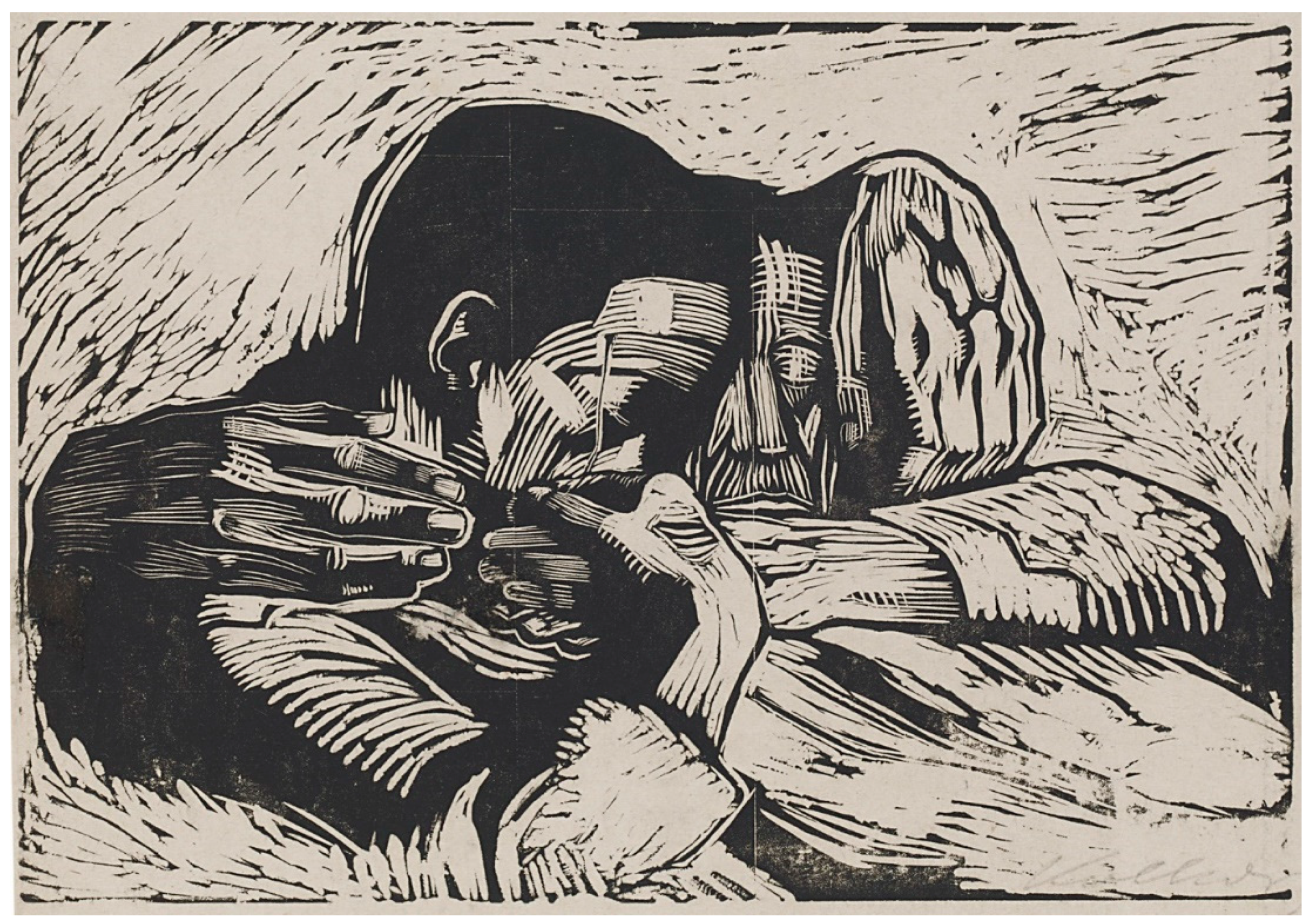
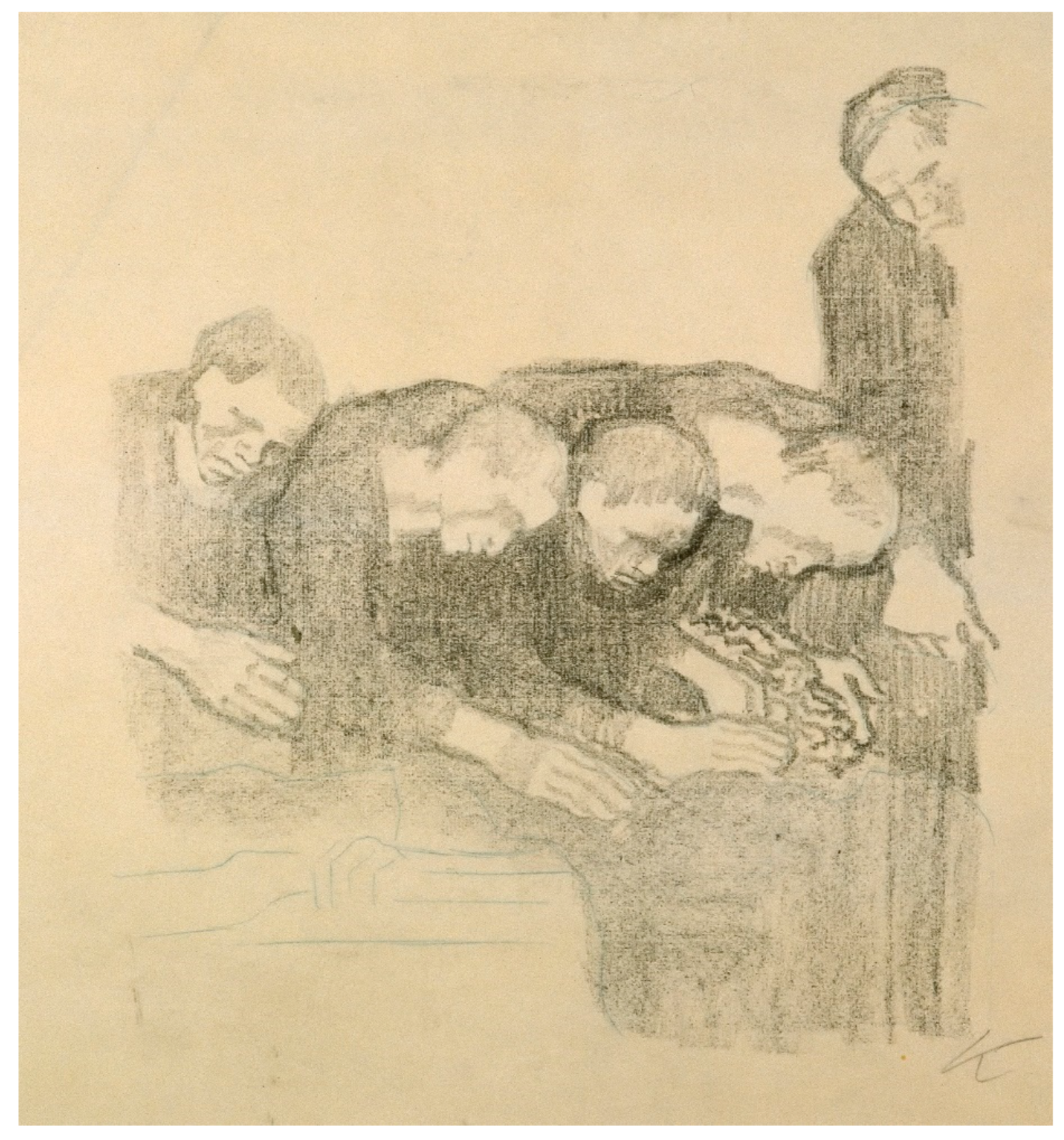

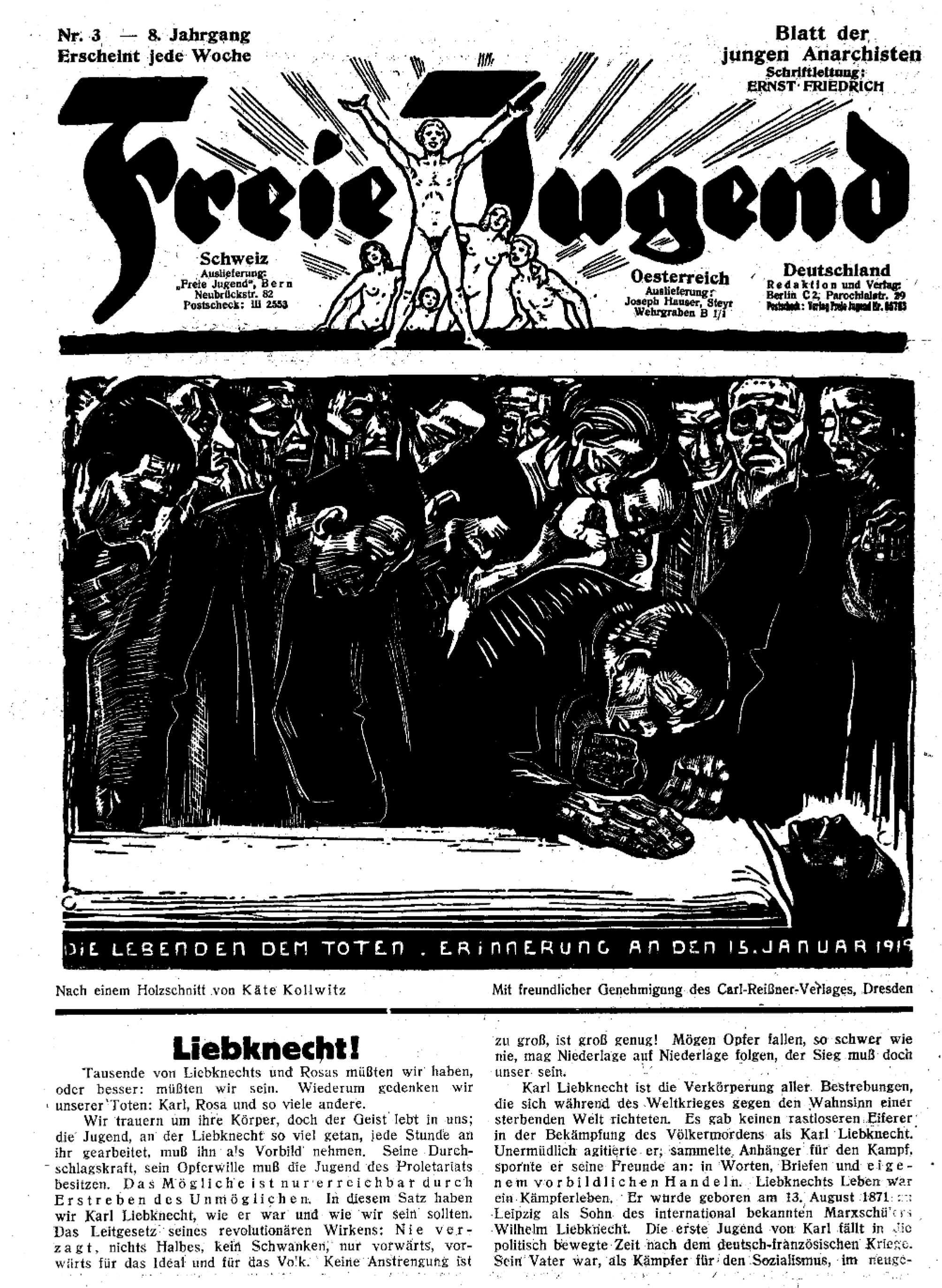

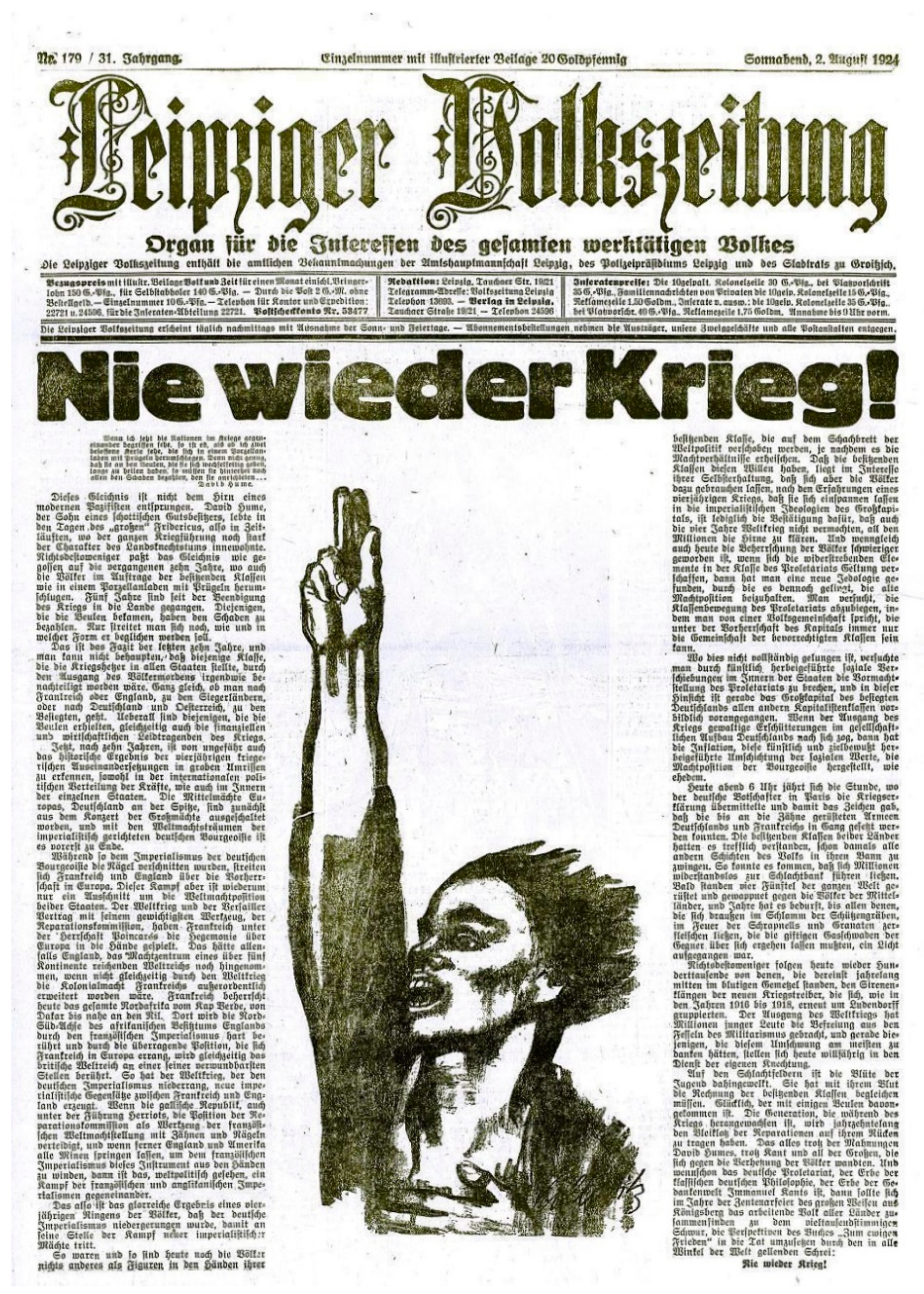
© 2020 by the author. Licensee MDPI, Basel, Switzerland. This article is an open access article distributed under the terms and conditions of the Creative Commons Attribution (CC BY) license (http://creativecommons.org/licenses/by/4.0/).
Share and Cite
Murray, A. Käthe Kollwitz: Memorialization as Anti-Militarist Weapon. Arts 2020, 9, 36. https://doi.org/10.3390/arts9010036
Murray A. Käthe Kollwitz: Memorialization as Anti-Militarist Weapon. Arts. 2020; 9(1):36. https://doi.org/10.3390/arts9010036
Chicago/Turabian StyleMurray, Ann. 2020. "Käthe Kollwitz: Memorialization as Anti-Militarist Weapon" Arts 9, no. 1: 36. https://doi.org/10.3390/arts9010036
APA StyleMurray, A. (2020). Käthe Kollwitz: Memorialization as Anti-Militarist Weapon. Arts, 9(1), 36. https://doi.org/10.3390/arts9010036




